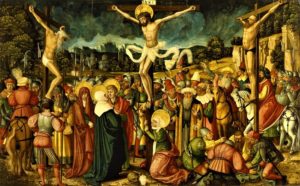
Crucifixion Is a common method of Capital punishment, also known as the death penalty, in which the victim was nailing or binding to a large wooden beam and left to hang, several days for death from exhaustion and asphyxiation.
Crucifixion it’s the method by which Christians believe their messiah, Jesus Christ, was killed. The origins of the word “excruciating”, a word we often use to talk about the feeling of extreme pain, are derived from the Latin words for “cross” and “crucified”.
This method of execution was supposed to cause excruciating pain. Crucifixion was a warning to all, karmic retribution written by the state: “This is what you get when you mess with us.”
The crucifixion site of Jesus is at a spot outside Jerusalem called Golgotha.
Crucifixion Roman
Crucifixion was considered one of the most brutal and humiliating modes of death. Crucifixion’s origins date back long before Jesus of Nazareth was crucified. The Persians had been crucifying wrongdoers as early as the 6th century BC, and there’s evidence that the Assyrians and Babylonians may have been putting people up on crosses hundreds of years before that.
The ancient Greeks though, were less interested in crucifixion, preferring methods like letting the condemned drink poison, but some historians mention at least one instance. That after capturing a Persian general, the army “nailed him to a plank and hung him up.”

Alexander the Great is the one man responsible for exporting crucifixion from Persia and spreading it to the western world, and in fact, he crucified thousands of his enemies. It wouldn’t be too long until the Romans got their hands on it and they’re the ones who really perfected it, but they didn’t often crucify their own.
This terrible method of killing was usually reserved for foreigners and Christian outsiders, although some slaves and soldiers that had disgraced themselves may have also been crucified.
Painful Death
A victim that had been crucified would often die within just a few hours. There were many ways a person might die, such as asphyxiation from being strung up in a way that prevented proper breathing.
They might also have been grievously injured from beatings prior to being hung up on the cross and simply die from their injuries once they were up there. But some people managed to hold on for a few days.
Roman soldiers were told to guard the sites where people were crucified, and if that person lasted too long, they might break the person’s legs to prevent them from being able to stand up straight leading to asphyxiation, or they might just simply drive a spear through the person’s heart.
Sometimes soldiers would break the leg bones to make it even more painful and harder to support themselves. Once this preparatory support was lost your arms would be pulled slowly from their sockets.
The weight of your own body would cause expansion of the chest and lungs, and with no way to push yourself up to relieve this, it leads quickly to asphyxiation. You essentially choke yourself to death. The heart would also suffer from this weight and you might even die from heart failure before your lungs gave out.
No matter what killed you first, it was an agonizing way to die. On some crosses, support might have been given in the form of a foot-rest, extending the time it would take for you to die, sometimes taking as long as a few days.
Crucifixion Of Jesus
The crucifixion of Christ happened in 1st-century Judea, most likely between 30 and 33 A.D. The record of Jesus Christ’s crucifixion in the four canonical Gospels starts with his scourging.
As per the canonical gospels, Jesus Christ was arrested and attempted by the Sanhedrin and then sentenced by Pontius Pilate to be scourged, and ultimately crucified by the Romans. The Roman soldiers mocked Jesus as the “Ruler of the Jews” they put a crown of thorns in Jesus’s head and led him slowly to Golgotha. Simon of Cyrene was permitted to help him in conveying the cross.

At the place of execution, he was stripped and then nailed to the wooden cross. His legs were affixed together with one iron nail then his hands were tied and nailed though and he likely died from asphyxiation. At the highest point of the cross was placed “the condemnatory inscription stating his crime of professing to be King of the Jews.”
Types of Crucifixion
Impalement
There was a wide range of punishment that could be Mentioned as a type of crucifixion. Sometimes impalement is said to be a form of crucifixion, though if a person found themselves impaled on a spike they didn’t live very long due to punctured organs and blood loss, so it isn’t quite the same as what we normally think of as a crucifixion.
In other cases, a person might be fastened to something with rope, and then left for days until they died. Again, a similar fate but missing that key component of a cross-shaped implement.
crux simplex
The thing a person was crucified on wasn’t always across though, sometimes it was just a pole and that was called, “crux simplex.” The term crux simplex was invented by Justus Lipsius between 1547 to 1606.
crux immissa
Then there was a version with the cross beam attached to the top in a T-shape and this was called the “crux commissa.” The one most of you know, and that became a symbol for Christianity, was called the “crux immissa.”
Despite it being used on reportedly thousands of people, archeologists have only unearthed one skeleton of a man that was crucified by the Romans around the time of Jesus.
He met his end in the first century and after some disagreements between archaeologists, it was agreed his legs were affixed together with one nail. His hands were tied but not nailed though and he might die from asphyxiation.
Recent Crucifixion Victim’s
The grotesque case of a 13-year-old girl who was crucified a couple of hundred years later. Her name was Eulalia of Barcelona. During the persecution of Christians, she was tortured thirteen times.
First, she was rolled in a barrel full of spikes and shards of glass, and then she was flogged for good measure. If that wasn’t enough, her now ripped flesh was iron combed with sharp teeth. This was followed by her being crucified and then decapitated.
Japan
The Japanese introduced crucifixion and famously in 1597, 26 Christians were crucified. In the 1860s a young Japanese man was crucified with his legs spread eagle, and there’s actually a photograph of this see The caption describes it as, “The manservant Sokichi, crucified at the age of 25 because he killed Nikisasuro, son of his master Nuiske in the village of Kiso, Japan.”
Burma
In the early 19th century a missionary working in Burma said it happened there. Here is what he wrote, “4 or 5 persons, after being nailed through their hands and feet to a wooden platform, had first their tongues cut out, at that point mouths are slit open from ear to ear, then their ears cut off, and finally their stomach ripped open.”
Australia
In the 19th century, an Australian man named Herbert James “Ringer” Edwards was crucified. He was a prisoner of war and had been building the infamous railway from Thailand to Burma under the Japanese government.
He and some of his other friends had been caught killing livestock for food. The Japanese soldiers strung him up with fencing wire to a tree and beat him, and then him to die. But others snuck the man food and after 63 hours he was taken down.
He lived to the ripe old age of 86, but two others that had been strung up with him did not survive.
Crucifixion is still Exist?
Nowadays in Saudi Arabia, a form of crucifixion is still exists, although there the person is first executed by decapitation and then their dead body is hung up on a beam. According to Amnesty International, “The body, with the separated head sewn back on, is hung from or against a pole in public to act as a deterrent.”